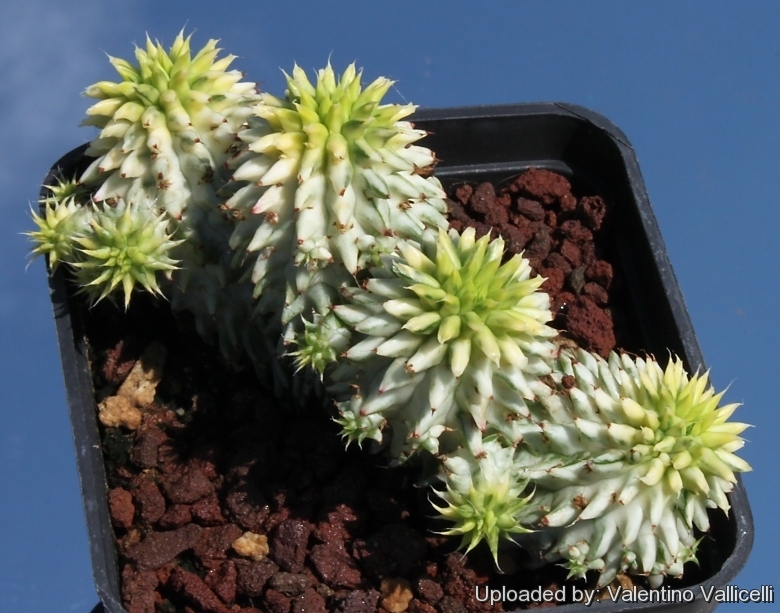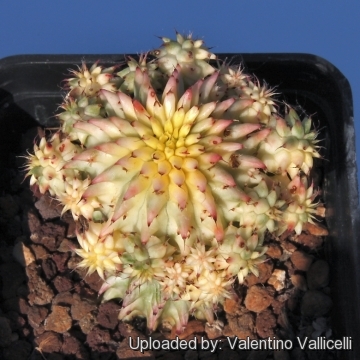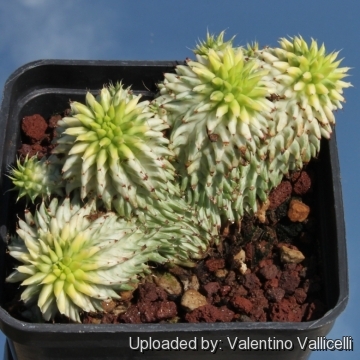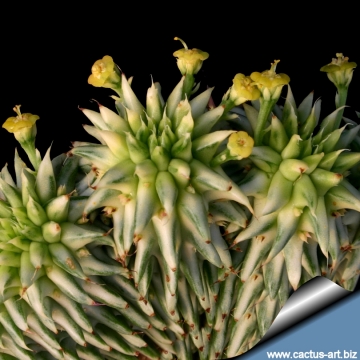Accepted Scientific Name: Euphorbia susannae Marloth
S. African Gard. 19: 191. 1929

Euphorbia susannae f. variegata Photo by: Valentino Vallicelli
Synonyms:
See all synonyms of Euphorbia susannae
Description: The common Euphorbia susannaeSN|15988]]SN|15988]] is a small clumping or (rarely) solitary succulent, that forms nice hemispherical clumps up to 10 cm tall and 30 cm in diameter. The variegated cultivars (Euphorbia susannaeSN|15988]]SN|15988]] f. variegata) has sectors or stripes with distinct shades of creamy-white, pale yellow or even pink in strong light. This form with variegated stems is very attractive and highly prized. The variegated form is usually seen grafted on stronger columnar species, but it can be grown on its own roots too, but stay much smaller.
Stems: Green, cream, yellow and pink, prominently tubercled, harmless, 12 to 16 angled. It produces a host of branches from the central roundish base (caudex).
Leaves: Reduced to short bristles on the young stems.
Flowers: Green or brownish cyathias in the fall or spring.
Subspecies, varieties, forms and cultivars of plants belonging to the Euphorbia susannae group
Notes: Variegation, albinism & schizochromism.
Variegation: A variegated plant has sectors, patches or stripes with two or more different colours, even distinct shades of green. Plants with variegated stems or leaves are often attractive and highly prized. In most species the stems or leaves are normally green, and variegated epidermis is an uncommon mutation, termed a chimera. A chimeral variegation is due to losing the ability to produce chlorophyll in some of the plant’s tissue, so that this tissue is no longer green. Tissues lacking chlorophyll are usually white or pale yellow coloured (due to carotenoid pigments) or red (due to betalain or anthocyanin pigments) contrasting with the normal green tissue. There are several forms of variegation, depending on the tissues that have been affected. The variegation in some forms is unstable. The extent and nature of the variegation can vary, and sometimes the plant will return to the green form. In others it is stable and does not change under normal conditions. Because the variegation is due to the presence of two kinds of plant tissue, propagating the plant must be by a vegetative method of propagation that preserves both types of tissue in relation to each other.
Albinism: Every once in a while a plant exhibits albinism (completely lacking chlorophyll pigment). This means that its tissue is unable to carry out photosynthesis. The result is a completely cream-white plant. This plant will be weaker than a green plant, and albinism is generally a fatal trait (it can't produce its own food and it's not getting it from anything else). Without chlorophyll, the albino plant has no way to manufacture the food needed for survival and growth to maturity. This implies that these plants cannot survive on their own roots and necessitate being grafted on a normal green plant that provides food. Some of these albino plants are indeed very popular, and sought after by collectors.
Schizochromism: The yellow or red appearance of some plants is more precisely caused by another aberration called "schizochromism". Here, though, the specific green pigment (chlorophyll) is missing: every other pigment is present at normal levels. The dominant green colouration is lost, but the plant will still more than likely have normal other pigments that give the yellow overall appearance of stems and the red colouration of spines.
 Euphorbia susannae f. variegata Photo by: Valentino Vallicelli
Euphorbia susannae f. variegata Photo by: Valentino Vallicelli Euphorbia susannae f. variegata Photo by: Valentino Vallicelli
Euphorbia susannae f. variegata Photo by: Valentino Vallicelli Euphorbia susannae f. variegata Photo by: Cactus Art
Euphorbia susannae f. variegata Photo by: Cactus ArtSend a photo of this plant.The gallery now contains thousands of pictures, however it is possible to do even more. We are, of course, seeking photos of species not yet shown in the gallery but not only that, we are also looking for better pictures than those already present.
Read More... Cultivation and Propagation: The variegated Euphorbia susannaeSN|16003]]SN|15988]] is difficult to grow on its own roots, and is generally grafted for convenience on Euphorbia canariensisSN|15754]]SN|15754]] or Euphorbia resiniferaSN|15988]]SN|16003]].
Frost Tolerance: Need frost protection.
Sun Exposure: Light shade.
Propagation: Grafting. The plants that are grafted on a more vigorous and easier stocks are easier to keep aand grow faster. The method of grafting euphorbias differs little from that of other succulents, except in one important aspect. The latex must be washed or sprayed off until hardly anything remains. After the latex flow has stopped, a further 1-2 mm slice can be taken from both surfaces without a new latex flow starting. Both scion and stock need to be at the start of the growing season. The stock should be cut as near as possible to the growing tip, as here the vascular bundles are dense and not yet woody and will feed the scion in the best possible way. Where possible stock and scion should be of similar diameter. The cut surfaces are held together with elastic bands in cross style, over the plant top and under the pot. The plants should be left in an airy and shady place for 7-10 days before the bands are removed.
Warning: As with all other Euphorbias when a plant get damaged it exudes a thick white milky sap known as latex. This latex is poisonous and particularly dangerous for the eyes, skin and mucous membranes. So pay extreme attention not to get any in your eyes or mouth. Cultivated plants must be handled carefully.













